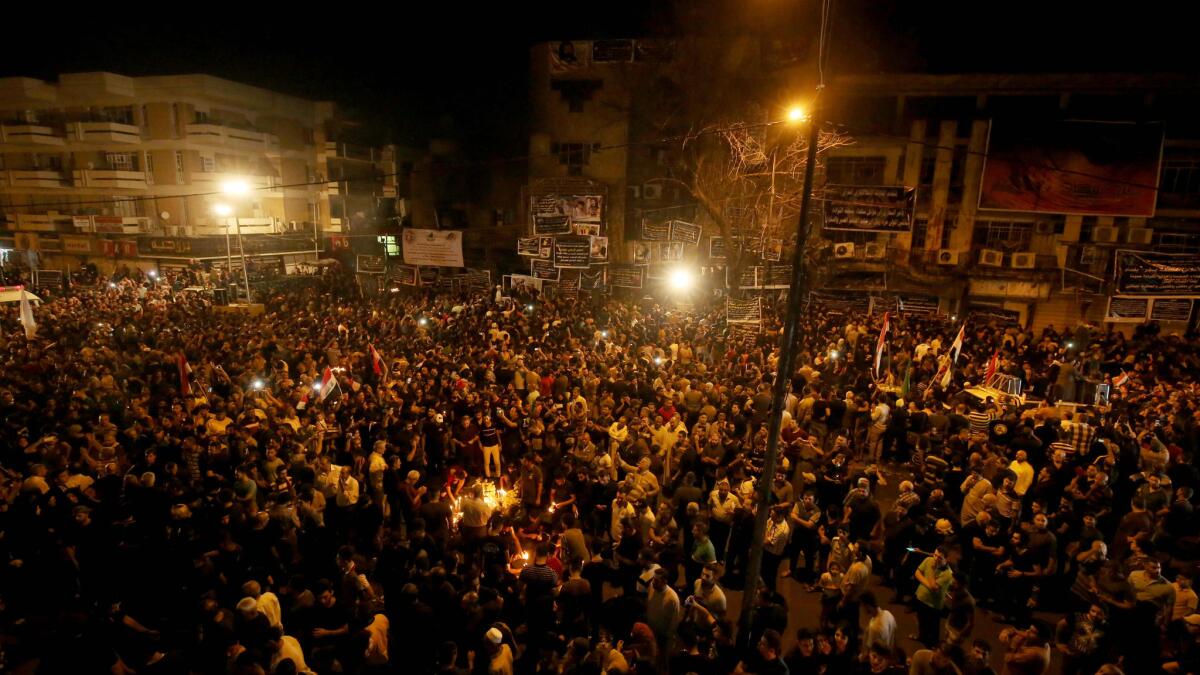This week’s Baghdad bombing is one of the deadliest Islamic State has carried out so far

- Share via
Even before the official death toll of Sunday’s bombing in Baghdad was revised, it was already one of the deadliest carried out by Islamic State in the war-torn country. All told, 250 people were killed, the Iraqi Health Ministry announced Tuesday -- making the attack one of the group’s worst worldwide, with nearly twice the number of dead as in last year’s Paris massacre.
The bomb was “unique,” even in a country where terrorist attacks have become depressingly familiar, said Mohammad Rubaii, deputy head of the Baghdad Provincial Council’s security committee. “I’ve never seen anything like this. Our investigations say there was a quarter ton of C4 in the vehicle, but we’re still examining the evidence.”
For the record:
11:45 a.m. July 6, 2016A map accompanying an earlier version of this article was mischaracterized as showing all car bombings in Baghdad from 2003 to 2014 and was improperly credited to Brilliant Maps. The map showed combat-related fatalities and was created by the Guardian newspaper, based on Wikileaks data. The article also reported that a bombing that killed 70 people occurred in March. It was Feb. 28.
He explained that the blast area was “somewhere between 600 to 1,000 square meters [approximately 6,400 to 10,760 square feet].” That’s roughly the size of two basketball courts.
RELATED: Islamic State shifts strategy from building territory to spreading terror worldwide »
The initial detonation instantly killed dozens who were out on the street shopping in the run-up to the Eid al-Fitr feast marking the end of Ramadan. The fire it produced burned bodies inside the three-level commercial complexes on opposite sides of the busy thoroughfare.
Rubaii added that 81 burned corpses had yet to be identified, while pictures posted online in the aftermath depicted entire interiors of buildings transformed into deadly infernos, the flames leaving only the skeletal remains of staircases and railings.
From Islamic State’s beginnings in 2003 as part of the Sunni insurgency fighting the U.S. invasion, to its most recent incarnation as a self-proclaimed caliphate controlling large swaths of Iraq and Syria, it has been blamed for frequent smaller-scale bombings in Baghdad.
Those attacks, which mostly targeted checkpoints at the entrance of Shiite-dominated areas, have been dwarfed by the death toll in the violence seen this year.
As Islamic State has seen its territories recede because of large-scale offensives backed by air support from warplanes of the U.S.-led coalition, its attacks have become larger in scope.
February saw 70 people killed in an attack on the impoverished district of Sadr City in Baghdad. The same suburb was struck again in May, when a car bomb killed 64 people in a market. Less than a week later, four explosions around Baghdad killed 69 people.
Over the years, authorities have struggled to contain the threat with checkpoints, snarling traffic in cities and adding hours to any commute on the country’s highways. Baghdad’s checkpoints are manned by a mix of bored police, militiamen and army soldiers equipped with “wands,” walkie-talkie-sized plastic boxes with an antenna attached that presumably detect explosive materials.
But the boxes have proved useless, and the British businessman who sold them to the Iraqi government for tens of millions of dollars, James McCormick, has been sentenced to 10 years in prison.
The city of Fallujah, 35 miles west of Baghdad, was thought to be the main source of the car bombs used to attack the capital. When pro-government forces took back the city from Islamic State in June, residents of Baghdad expected the attacks would subside.
The sheer size of the attack in Karada, a Shiite-dominated area that has been the site of several bombings in the past, has triggered a furious backlash from Iraqis fed up with the government, sending officials scrambling for solutions.
On Sunday, Iraqi Prime Minister Haider Abadi, after escaping in his convoy from a mob of angry Karada residents who pelted his car with bricks and cursed at him, ordered all “wands” withdrawn from checkpoints around the country. He also ordered the Ministry of Interior to reopen corruption investigations related to the devices.
But others were not mollified.
“There needs to real reform of the security matrix … not just removing the [ineffective detectors]. What’s the use of removing the detectors? What is the alternative?” asked Iraqi Minister of the Interior Mohammad Al-Ghabbaan in a televised speech on Tuesday announcing his resignation, adding that Baghdad checkpoints had been able to detect only 3% of threats to the city.
“There needs to be structural reforms of the security organization. Without them, I cannot take responsibility for the blood [that is shed].”
ALSO
Islamic State tightens grip on Yazidi captives held as sex slaves, selling them on apps
Here’s who carried out the Bangladesh attack: Mostly students from middle-class families
Jordan scholar falls from government grace after criticizing role in fight against Islamic State
More to Read
Sign up for Essential California
The most important California stories and recommendations in your inbox every morning.
You may occasionally receive promotional content from the Los Angeles Times.














